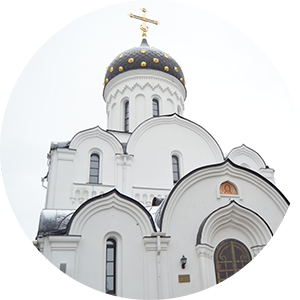Few know that
the story of St. George slaying the dragon is not just a legend, but a real
story about a real person, who lived in the 4th century in the city of Lod.
What is more, after his martyrdom he was buried on the territory of present-day Israel.
 The ancient
city of Lod (Lydda) has a centuries-old history. It is known, that the Jews from
the tribe of Benjamin were living there. Apostles Peter and John were preaching on that territory at the time of the New Testament. Apostle Peter cured a person whose name was Aeneas, while he was there. However, at the time of early Christianity the
fate of the city was mostly connected with the life of St. George.
The ancient
city of Lod (Lydda) has a centuries-old history. It is known, that the Jews from
the tribe of Benjamin were living there. Apostles Peter and John were preaching on that territory at the time of the New Testament. Apostle Peter cured a person whose name was Aeneas, while he was there. However, at the time of early Christianity the
fate of the city was mostly connected with the life of St. George.
The Greek
Orthodox cathedral in the name of St. George was built there in the 4th
century. According to the story of the Church of Jerusalem, the Saint
spent his childhood there and after his death in 303 in Nicomedia, his holy
relics were moved back to his native city of Lydda, where his mother lived. The
church survived the attack of the Persians in 614, but it was destroyed by Egyptian
caliph Hakim in 1009. In the 11th century it was restored by the
order of Byzantine emperor Constantine IX Monomachos.
In 1442 the
western part of the church was conquered by the Muslims and turned into a mosque.
At the same time the right chapel named in honor of St. John the Evangelist was
separated from the church and destroyed.
In the second
part of the 19th century Patriarch of Jerusalem Krill II organized a
great restoration process, and the church was blessed for the second time. The
central chapel was devoted to St. George the Victory-Bearer, the left one – to the Entry of the
Most Holy Theotokos into the Temple. In the crypt of the church there is a
cenotaph (an empty tomb or a monument). The priests spill blessed oil on it, so
that the pilgrims could anoint themselves and take a bit of it along.
A part of the
holy relics of St. George is kept in a small silver box in the central chapel
of the church. Sometimes the relics are taken out to the people, so that they can
venerate them. In one of the columns another sacred item is kept – “the holy
fetters”, with which the Saint was enchained in his jail. What is more, in the
church of St. George there is a unique tradition. Orthodox pilgrims pray and
then voluntarily put these fetters on. People say, this helps to cope with any
disease.
The most famous
feat of St. George is his victory over the beast, which was killing people near
the city of Beirut. However, there is also another, lesser-known feat. When the
Saint proclaimed himself as a Christian, the Roman emperor Diocletian sentenced
him to severe tortures. St. George endured all the sufferings and did not renounce
his faith. During his imprisonment, the Saint asked a warden to let his servant
visit him. When the servant came, St. George asked him to take his body after
the execution and bury it in Palestine. The servant did exactly what his master
said to do. He took the beheaded body of the Martyr and buried it with honor.
Translated from: http://simvol-veri.ru/xp/obnovlenie-osvyashenie-xrama-velikomuchenika-georgiya-v-lidde-16-noyabrya-2010.html
 |
| Help support the ministry of St. Elisabeth Convent |



















CONVERSATION